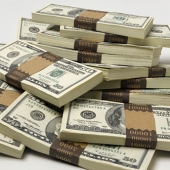The best way to detect a counterfeit bill often depends on the context, such as the type of establishment, the size of the bills it normally handles, and the number of customers waiting when the counterfeit is presented.
 The fingers of cash handlers are the most widespread defense against counterfeit bills in the United States today. In the intaglio process used for United States currency, very heavy plates force inks deep into the paper fiber, giving genuine currency a texture most counterfeit bills don't have.
The fingers of cash handlers are the most widespread defense against counterfeit bills in the United States today. In the intaglio process used for United States currency, very heavy plates force inks deep into the paper fiber, giving genuine currency a texture most counterfeit bills don't have.
That process can really be a hit-or-miss proposition, though, especially in busy establishments. Many bosses just tell their workers to quickly inspect larger bills. How well these “visible” scans work depends on the quality of the counterfeit bill presented. Easily-spotted counterfeits may still be accepted by busy employees in dim light, or when several customers are waiting for them. Counterfeit bills copied with image processing software from genuine currency do not have the texture or fine detail of a real bill. Bleached five-dollar bills printed with the image of a larger-denomination bill, on the other hand, feel genuine because their paper is genuine. These counterfeit bills can only be spotted by someone who knows what to look for. Other counterfeits rival genuine currency in quality and are very difficult for the average person to detect without special readers.
Looking for the following security features can catch many counterfeit bills:
- A watermark should appear when you hold a bill to the light. It will be the portrait printed on the bill, and will appear to its right. Watermarks are easily faked however, so this check eliminates only the crudest counterfeits.
- The security thread, a fine plastic strip embedded in the paper, runs from the top of the bill to its bottom. Its left-right position depends on the bill. It too is seen when you hold the bill to a light, as well as printed characters along its length, saying either USA 50, USA 100, USA TWENTY, USA TEN or USA FIVE. Security threads glow when placed under an ultraviolet light -- orange for a ten, green for a twenty, yellow for a fifty and red or pink for a hundred dollar bill.
- US bills above $10 use an ink that changes color with the light, but the change can be difficult to verify in dim lighting such as you might find in bars or taxis.
- Microprinting, very fine detail invisible to the naked eye, is beyond the capabilities of most counterfeiters. However, verifying this requires a magnifying glass, and most retailers don't want to make customers feel untrusted.
How reasonable is it to expect your cashiers to conduct one or more of the above “visible” test to detect a counterfeit bill?
High-employee-turnover in retail stores and quick-service-restaurants means many businesses need a fast and easy solution that their cashiers can use to detect counterfeit bills. And – the cost of such a solution matters, especially to smaller businesses.
- Magnetic ink character readers are very inexpensive and easy to use, but generally only verify that magnetic ink is present. This won't detect washed counterfeit bills with magnetic ink that's wrong for the printed denomination.
- Ultraviolet ink on the other hand is difficult to counterfeit and easily checked. Ultraviolet lights are also relatively inexpensive but still rely on a human to decide whether the bill is good.
- Infrared printing is most useful for vending machines and automated money counters. It's hard to fake but also hard for humans to verify.
Machine readable character readers may provide a solution. The most effective readers verify a number of characteristics before declaring that a bill is genuine. Such readers are probably most appropriate for businesses that sell higher-end items like money orders or cell phones often paid for with large bills. Ultraviolet lights may be the most cost-effective solution for busy retailers who are usually paid in small bills for relatively small transactions.



